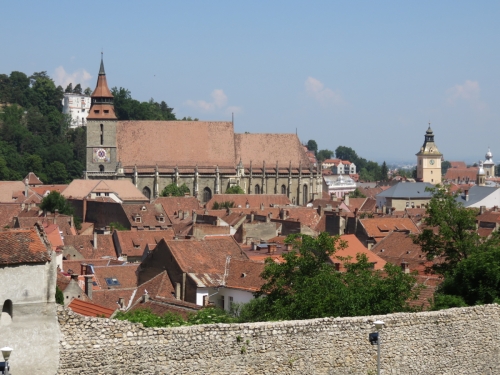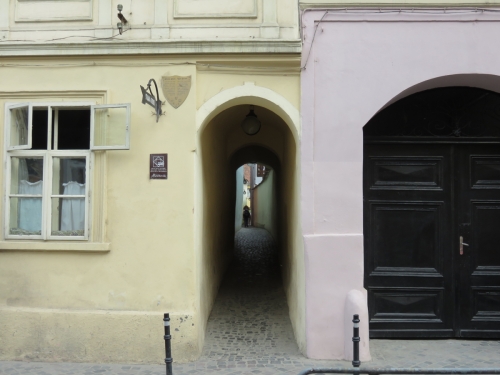Transylvania evokes for most people spooky castles, rocky hillsides, and forlorn towns.
And, to be honest, all of this it has in spades.
But what I learned after some cursory research is that there’s a rather spectacular city tying it all together: Brașov.
The city was right along the prime trade route between Istanbul and Vienna, and was one of the largest safe havens for merchants as they plied the dangerous route.
In order to defend Brașov, the city was built in a deep valley, with an intensive network of walls and fortifications.
The result is an extremely compact and wealthy medieval town, ripe for exploration.
Brașov was actually founded by Germans, with a special tax exempt status to entice Germans to move there. The Black Church is a Gothic masterpiece: the largest Lutheran cathedral between Vienna and Istanbul, meant to make an impression on the Islamic merchants who came through town.

Brașov’s main gate. The four spires standing around the corners of the tower signified “jus gladii” in Brașov; the town has the right to impose capital punishment on those found of wrongdoing within its walls.
The main square, the location of many-a-horror, including, supposedly, the last witch trials in Europe.
The city’s coat of arms–the roots of a tree coming out of a crown.
Brașov boasts one of the narrowest streets in Europe!
With Brașov proper established as a city for Germans only (although the German population was reduced to almost nil in the following centuries), Brașov’s original suburb, south of town and deeper in the valley, was built for Romanians. Piatra Unurii (Union Square) anchors the sedate Romanian part of town.
Of course, the obligatory creepy Transylvania graveyard picture. Note the four spires at the corners of the church tower–in this case, signifying that the Priest is able to administer capital punishments as he sees fit.
Brașov’s main pedestrian street, catering mostly to local Romanians. Tourism is substantial in Brașov, but it maintains a large enough pull in Romania to keep a very local feel. The cultural and historical appeal in an under the radar city reminded me of Guanajuato, Mexico.
Also, given the city’s natural setting, gorgeous views abound–you just need to hike a little ways uphill in pretty much any direction!
Brașov is adorned with a Hollywood-style sign on the hillside. You can’t really blame them: back in Soviet times, this was the city Romania decided to name for Stalin–the name was imposed onto this very hillside.
Climbing the mountain east of town brings you to the top of a cablecar, and a fantastic view!
At the top there’s a cafe serving mici–little delicious seasoned pork logs. The perfect snack after tromping straight uphill for 45 minutes!
The cable car, an old Soviet affair–and well worth the $2 to take you back down!
Most of the traditional Hungarian restaurants I came across in Budapest felt made for tourists. Not so in Brașov! Meat-vegetable-sauce combinations to make the mouth water.
Brașov isn’t a completely idyllic, medieval place. Ceaușescu, the country’s longtime communist leader, had a strong affinity for main streets lined with glorious high rises, and built them across Romanian cities.
At least the Old Town was spared of this aesthetic.
Old and new.
At this point you might be wondering: where’s Dracula? Well, despite Brașov’s links to the character being pretty tenuous, I did manage to find a Vlad Tepeș Street in the communist district, named for Vlad the Impaler, the figure upon whom Dracula is loosely based.
And this little graffiti tag!























That last street tag is amazing. The Black Church looks straight out of Castlevania, too.
By: Jared on June 17, 2015
at 1:39 pm
[…] But you know better than to think those four spires at the corners are just a touch of whimsy, right? […]
By: Into the Countryside | Cape to Milan on June 18, 2015
at 1:26 pm
[…] the post about Brașov, I noted that ex-dictator Ceaușescu for whatever reason really liked for main boulevards to be […]
By: A Day in Bucharest | Cape to Milan on June 19, 2015
at 12:38 pm